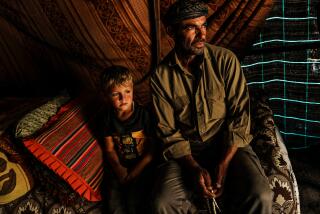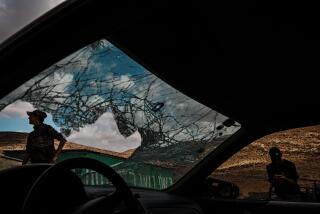Questions Lurk in a Dead Village
QALAYE NIAZI, Afghanistan — No one can be found to tell this story firsthand. There is disagreement from those who live nearby about the details of the bombing.
But what is clear is that where a small village once stood in the arid plains of east-central Afghanistan, there is little left but torn clothing, piles of brick, pieces of human flesh and hair, and a substantial stockpile of small-arms ammunition.
The United States launched a fierce bomb attack on Qalaye Niazi before dawn Dec. 29, as its inhabitants slept after a wedding celebration. Ten homes are said to have been destroyed and dozens of people killed; the exact numbers are in dispute.
What isn’t clear is why the village became an American target.
The story of Qalaye Niazi raises difficult questions about the accuracy of the local information the United States is getting about the whereabouts of remaining Al Qaeda fighters. In this instance, and in the Dec. 20 bombing of a convoy of tribal elders headed to Kabul, the capital, for the new government’s installation, it appears that the U.S. military may have unwittingly become prey to misinformation from local tribal chiefs and their cohorts, all of whom are competing for power and territorial control.
“People have received satellite phones for working as local agents. And there have always been enmities and tribal disagreements in the area,” said Fazlullah, governor of Lowgar province, just to the north of Paktia province, where the bombing took place.
“There is no specific argument, just settling old scores and revenge. As each regime has come they have wanted revenge on those in the previous regime that have been unjust or cruel,” said Fazlullah, who uses only one name.
Maj. Brad Lowell, a spokesman for the U.S. Central Command in Tampa, Fla., acknowledged that American forces have given out satellite phones to local Afghans to help identify suspected Al Qaeda and Taliban hide-outs. He said those reports are always double-and triple-checked with U.S. special operations forces on the ground, intelligence reports from reconnaissance aircraft and other sources.
U.S. Special Forces have been in close contact with local groups in the country for more than 90 days, Lowell said.
Regarding the concern that the Afghans might steer U.S. warplanes wrong, Lowell said: “We recognize the possibility of those types of scenarios, and it’s not like we would let someone like that call in the airstrike. There is a process that we have. There are checks and balances set forth to keep that from happening. We shouldn’t rely on just a single piece of information.”
The Qalaye Niazi episode epitomizes the dilemma the U.S. faces at this stage of the war in Afghanistan. If the military is going to eliminate every suspected former Taliban fighter still drifting around Afghanistan, civilian deaths may be unavoidable.
In the minds of tribal elders, relatives of Qalaye Niazi residents and leaders of neighboring provinces, there is no doubt that the inhabitants of the village were civilians, innocent of any activity related to terrorism. The United States military has claimed that Taliban leaders were hiding among the villagers.
“These were just civilian people, businesspeople, poor people and nomadic people,” said Haji Saifullah, head of the tribal council, or shura, in Paktia province.
“The Americans received incorrect information to bomb that place,” Saifullah said. “Maybe someone told them that they were Al Qaeda or Taliban. There are so many people who have satellite phones. The person may have reported that for revenge.”
According to U.S. officials, two surface-to-air missiles were fired at the bombers during the raid. “We have identified that as a military target,” Lowell said, adding that the Pentagon has investigated the Qalaye Niazi strike damage. “We have multiple ways to confirm.”
There are few black-and-white situations in Afghanistan. A walk around Qalaye Niazi, for instance, makes clear that women and children were killed by the U.S. bombing--there are fragments of skull with black braided hair decorated with silver thread--an accessory common among women in this region. And in Afghan society more than many others, women have no role in the country’s military or political life--they are true civilians.
But it is also evident that tons of munitions were stored here--hundreds of boxes of .50-caliber machine-gun bullets used in antitank weapons, antitank shoulder-fired missiles, crates of rocket-propelled grenades, 90-millimeter shells and mortar rounds. What was a village of about 100 people doing with all that ammunition?
Further complicating matters, many Taliban officials have melted into civilian life, and many tribal rivalries that have simmered for years have broken into the open.
“These tribal feuds have always been there--over land rights, water rights--and when the Taliban left it was a free-for-all and everyone wants a fiefdom of their own,” said Amir Usman, the former Pakistani ambassador to Afghanistan.
“The U.S. does not understand the ways of Afghans, the willingness to go to any lengths to eliminate an enemy, and these satellite phones appear to have been distributed rather indiscriminately,” he said.
Paktia province, where both of the recent controversial bombings occurred, lies along the east-central border of the country, where mountain peaks rise to more than 10,000 feet. Some local residents and commanders say Al Qaeda members and senior Taliban leaders passed through the province on their way to hiding places in the mountains or in Pakistan. It is difficult to know if a few are still hiding in small villages such as Qalaye Niazi.
Qalaye Niazi is a collection of hamlets separated by long stretches of Afghan plain. The dwellings that were bombed, about two miles from Gardiz, the provincial capital, housed farmers and at times some of the Kuchi people, who are nomads.
A week after the bombing, neighbors were still picking through mounds of rubble, searching for the dead. They said 10 houses were struck.
Strewn about were what appeared to be the remains of simple lives. Pink, yellow and blue dresses elaborately embroidered with flowers and leaves, and shawls far more colorful than those worn elsewhere by women in Afghanistan, lay on the ground. Half buried under some bricks was a child’s severed shoe. And vanishing into the desert dust was flour from a large metal bin whose top was twisted off by the powerful bombs.
On the night of the bombing, the village had more than its usual number of people because Bahram Jan, a farmer, was having a wedding party for his son. Members of the bride’s family had come from as far away as Jalalabad, several hours by road, said Sher Khan, an elderly man who lives in a nearby village and lost seven relatives and a car the night of the bombing.
The roar of the planes started around 3 a.m., and then the bombs began to fall, according to neighbors who watched from a distance, some of whom climbed on their roofs to see what was happening by the light of the nearly full moon. Accounts are not completely consistent, but several people said the planes flew three sorties over the village and a helicopter hovered close to the ground firing flares and then rockets.
“I got on the roof and I thought to myself, ‘They are destroying my family,’ ” Khan said. “I saw the people running from the village in the light of the flares and the moon.”
Villagers said a number of women and children ran from the houses toward a dry pond and irrigation canals, probably in search of protection from the rockets and bombs, but were killed as they ran. An initial investigation by the United Nations said the charges were well founded.
After two hours, the aircraft left and dozens of people lay dead. The United Nations report, which was based on a source’s information that U.N. officials described as reliable but unconfirmed, said that 52 people died: 17 men, 10 women and 25 children. Among them were six neighbors who rushed to the village to rescue victims but were fired upon, the U.N. said. Khan said 48 people were still missing but that they had buried 10 people. In one grave, he said, they put the remains of three bodies, and in another a number of pieces that could not be identified.
Near the destroyed homes, the ground is covered with unexploded ammunition--much of it Russian- or Chinese-made varieties that the United States does not use. Three buildings that were damaged were packed with unopened boxes of bullets. Clearly this village was a major ammunition dump, but for whom?
The elders of the Paktia tribal council say the munitions were government property that predated the Taliban. They say the munitions were moved to the village because they feared they would explode and cause civilian casualties if Gardiz was targeted in the U.S. air campaign.
But anti-Taliban soldiers who accompanied visitors to the village said they had no doubt that the Taliban had put the munitions there.
It is unclear why the United States left the ammunition intact rather than destroying it. Much of the ammunition still looks as if it could be salvaged.
As the shadows lengthen and the winter air turns chill, four women, their blue and pink veils blown by the wind, walk steadily toward the destroyed hamlet. They have come to look for relatives who are missing. As they approach, a plane streaks high overhead. A few men picking through the rubble look up nervously. The plane makes a second sweep in the other direction. The men call out to the women that it is not safe and that they should turn back.
Will anyone ever return to this village?
“No one is alive to come back,” said Haji Taj Mohammed. “We have not seen any wounded.”
*
Times staff writer Esther Schrader in Washington contributed to this report.
More to Read
Sign up for Essential California
The most important California stories and recommendations in your inbox every morning.
You may occasionally receive promotional content from the Los Angeles Times.










